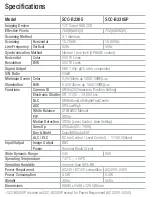
Introduction
Page 4
Principle of
Operation
The HandPunch uses low-level infrared light, optics, and a CMOS (IC chip)
camera to capture a three-dimensional image of the hand. Using advanced
microprocessor technology, the HandPunch converts the image to an electronic
template. It stores the template in a database with the user’s ID number.
To gain punch, the user enters his or her ID number at the HandPunch’s keypad
or uses an external card reader. The HandPunch prompts the user to place his or
her hand on the HandPunch’s platen
1
. The HandPunch compares the hand on
the platen with the user’s unique template. If the images match, the HandPunch
records the transaction for processing.
The
HandPunch
Terminal
The HandPunch is a time and attendance terminal designed for use with time
and attendance software. Refer to Figure 1-1 on page 5 when reviewing the
information in this section.
The HandPunch has an integrated keypad for ID entry (see Figure 1-1). The
and
keys are used for data entry and programming.
Four different features assist the user with hand placement and read verification.
1. A light emitting diode (LED) hand placement display on the HandPunch’s top
panel assists users with hand placement on the platen.
2. A liquid crystal display (LCD) shows operational data and programming
menus.
3. “Red light/Green light” verification LEDs quickly inform users if their verifica-
tion attempts were rejected or accepted.
4. An internal beeper provides audible feedback during keypad data entry and
user verification.
1. The Platen is the flat surface at the base of the HandPunch (see Figure 1-1). This is where
users place their hands for enrollment and verification. It has guide pins to assist
positioning the fingers during use.
CLEAR
ENTER
Summary of Contents for HandPunch 1000
Page 4: ...Appendix D Troubleshooting 63 Glossary 65 Limited Warranty 67 ...
Page 10: ...Introduction Page 8 This page is intentionally blank ...
Page 22: ...Wiring Connections Page 20 This page is intentionally blank ...
Page 24: ...Ereasing Memory Page 22 This page is intentionally blank ...
Page 26: ...Ereasing Memory Page 24 This page is intentionally blank ...
Page 30: ...Enter a Command Menu Page 28 This page is intentionally blank ...
Page 48: ...Maintenance Page 46 This page is intentionally blank ...
Page 50: ...Appendix A Tips Page 48 This page is intentionally blank ...
Page 52: ...Appendix B Board Configuration Differences Page 50 This page is intentionally blank ...
Page 64: ...Appendix C Page 62 This page is intentionally blank ...
Page 68: ...Glossary Page 66 This page is intentionally blank ...
Page 70: ...Warranty Page 68 This page is intentionally left blank ...







































